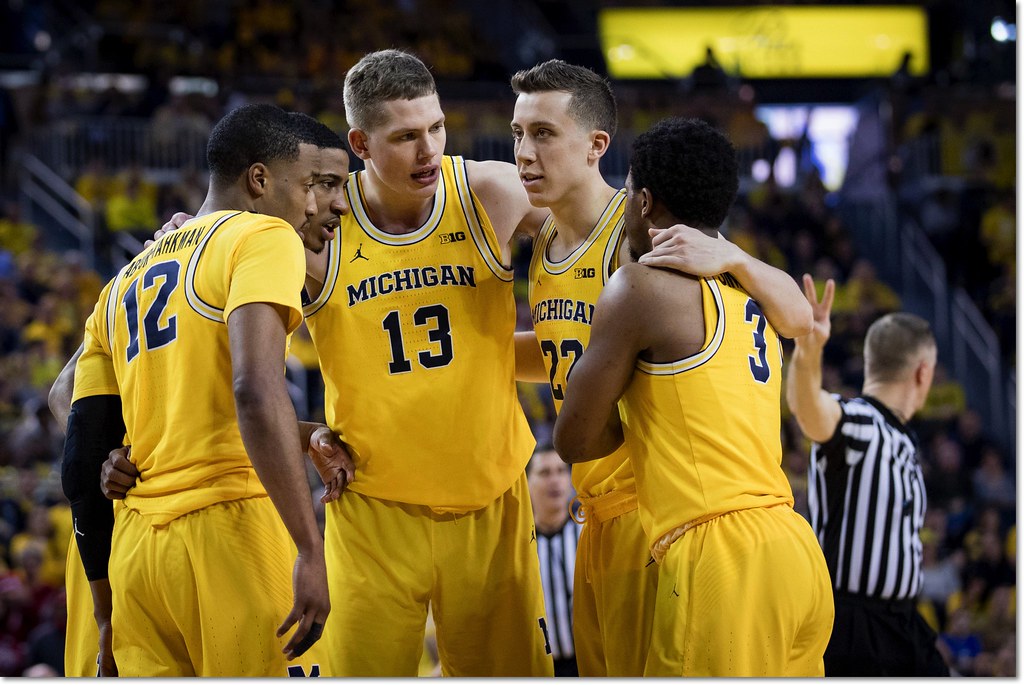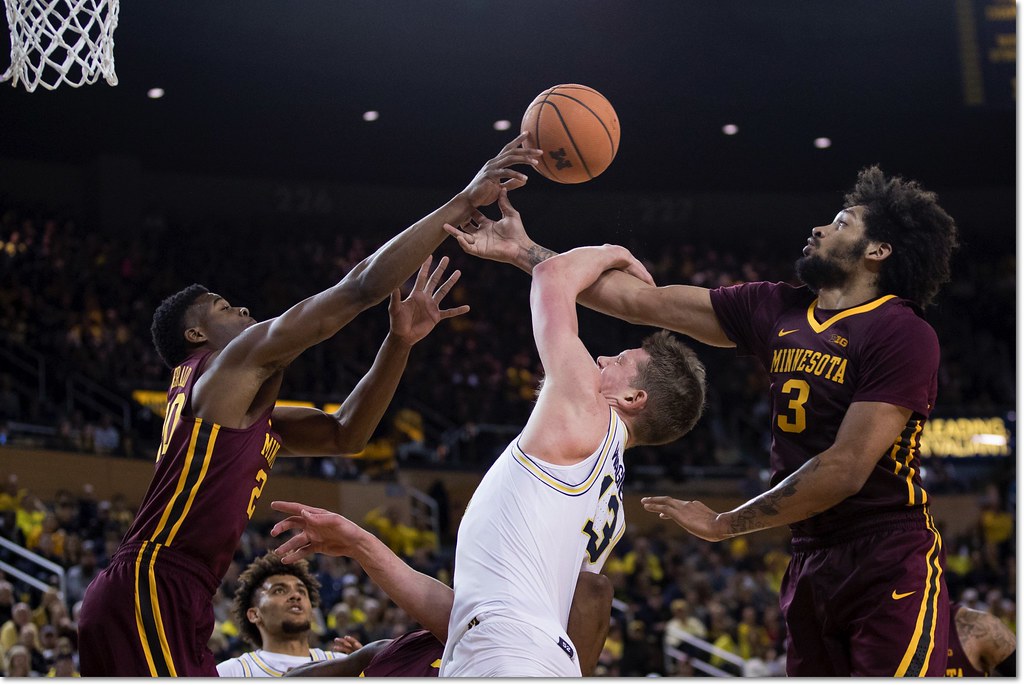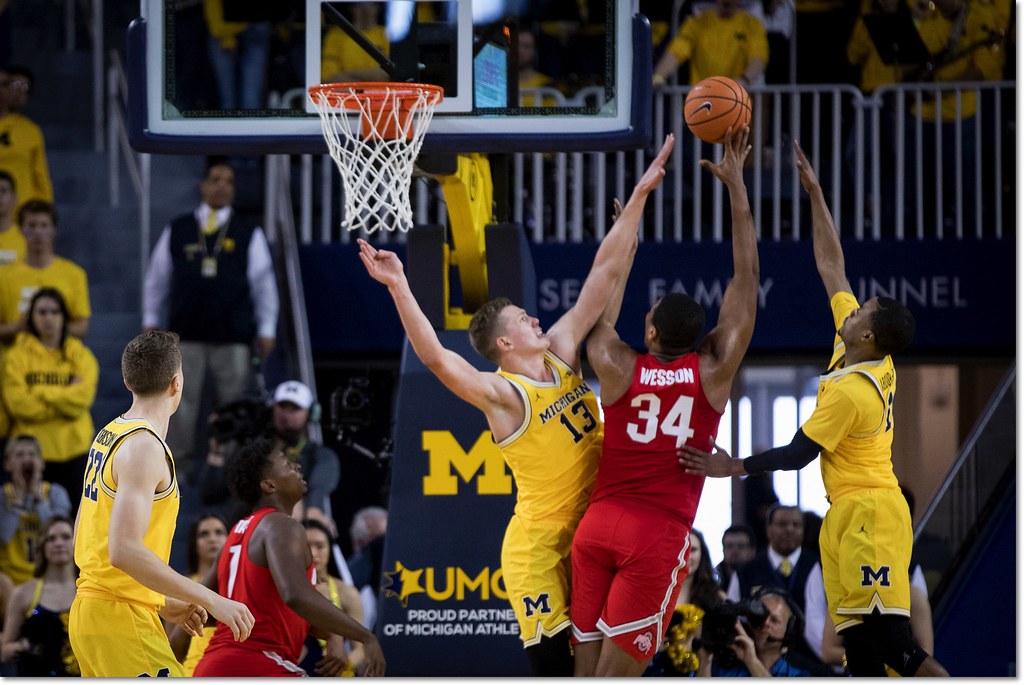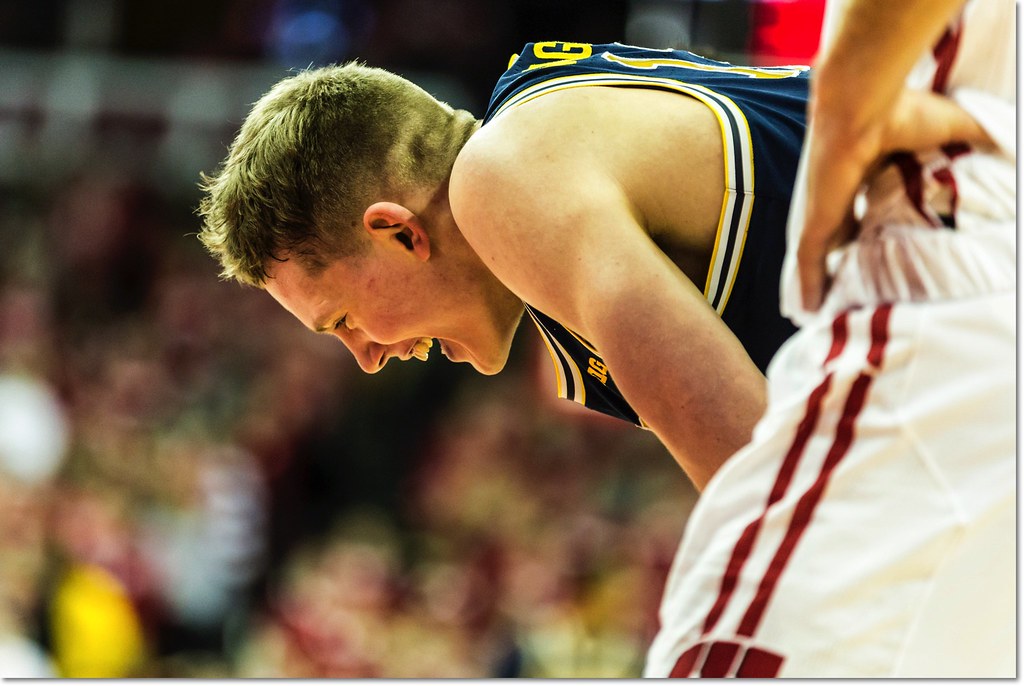Pre-BTT Hoops Mailbag, Part Two: Lineup Combos, Facing Nebraska-Types, Fouling, NBA Futures

If you missed it, here's part one of the pre-BTT mailbag, and today's podcast also featured extensive hoops discussion. Let's get right back to it.
Lineup Combos: Unlocked

Recent adjustments have given Beilein more lineup flexibility. [Marc-Gregor Campredon]
Earlier in the year a Wagner/Livers and Teske/Robinson rotation was greatly desired. Has Robinson's defensive renaissance negated the need for those substitution needs? #mgomailbag
— Austin (@Lofter4) February 27, 2018
It has indeed. When I ran a mailbag in mid-December, those lineup pairings were necessary to keep the team afloat. They aren't anymore.
While Isaiah Livers still holds the starting job, his minutes have faded significantly. Per KenPom, Duncan Robinson has played 71% of the minutes at the four over the last five games, and it's because he can be on the floor with Wagner again. Since conference play resumed, Michigan scores 1.13 points per possession and allows only 1.02 when the Robinson/Wagner combo is on the floor. The numbers get even starker when you look at the nine-game stretch since the second Purdue game, which I believe is around the time Luke Yaklich made his defensive tweak to keep Robinson mostly in the post:

via HoopLens
The defensive numbers are impacted by some three-point luck (good for Robinson/Wagner, bad for other lineups) but there are still some significant takeaways. First, the offense is lethal when Wagner and Robinson are both hitting their threes—no surprise there. The other stat that stands out to me is their ability to dominate the defensive boards. Wagner has really stepped up his game as a rebounder; Robinson doesn't go get them often, but he's done a great job of sealing off his man—usually an offensive rebounding threat—to allow Wagner and the guards/wings to swoop in and grab the ball.
So long as the impact of these defensive adjustments remain, we should continue to see Robinson play around 30 minutes per game, even if Livers continues to start. Robinson is much more impactful on offense and his hidden impact on rebounding (plus his solid post defense) has made him a more valuable defender of late than Livers. (I can't believe I just typed that.)
Luke Yaklich unlocked Michigan's best lineups. With Robinson playable on defense again, John Beilein can be comfortable putting out groups like Simpson-MAAR-Poole-Robinson-Wagner that are capable of ridiculous shooting stretches like the 51-points-in-15-minutes torching of Maryland. That's been missing from the M offense this season; it's back now.
[Hit THE JUMP for the rest of the mailbag.]
Facing All-Switch Defenses

Quick, athletic defenses can give Michigan trouble. [Campredon]
Hi Ace,
I'm a big fan of your writing. It seems like when watching M's offense, it usually does well against big, strong teams (Purdue and Michigan State this year) and struggles against quicker teams, even if they don't have size (like Nebraska this year). I remember a game in Puerto Rico against Charlotte a few years ago where M got beat by a small, quick team that played pressure defense. It seems teams that can switch screens (aka have fast big men) also give us trouble. Two big things to punish teams that go small are post up and get offensive rebounds, and M doesn't usually try to do either. Maryland started the second half with a 6'4" center - and got away with it for a while.
You think there's any truth to my theory?
Thanks for your hard work - hang in there!
Luke
Longmont, CO
I'm not even going to bother with numbers here: you're not wrong, Luke. From a strategic standpoint, it makes sense that Michigan would struggle more against teams like Nebraska that can switch their bigs (and has bigs who are comfortable on the perimeter) than those like Purdue that feature a paint-bound center. There's a reason big men who can switch onto wings/guards are so coveted in today's NBA; it's the best way to combat the perimeter-oriented offenses that are taking over the game. In Wagner's case, it makes it harder for him to both get open three-point looks (his release is still rather slow) and beat his man off the dribble.
There are ways to combat this that I'm sure Beilein has already worked on, and the extra week to prepare between the BTT and NCAA tourney should help in that regard, especially once Beilein knows his opponent. It's worth noting the Nebraska debacle was largely a schedule loss; that was M's third game in six days while the Huskers had two full days to prep with no travel. I'm still rooting for M to draw teams that play more traditional centers.
Another Shift In Defensive Approach: Hacking

Making them earn it. [Campredon]
Tweeted this to you the other day, but would be interested in seeing a look at Michigan's fouling this year. Is it up? By how much? Is it up over the course of the season? Feels like yes.
— Christopher J Kringle (@dkkeoodk) February 27, 2018
This is something I should've noted when discussing the fundamental changes Yaklich has made to the defense. Prior to this season, none of Beilein's teams at Michigan have ranked lower than 42nd in opponent free throw rate, and that was back in 2011; the Wolverines haven't finished below 25th since.
This season, Michigan ranks 100th in that stat. It's no coincidence that this team has the program's best block rate since Beilein's first squad here, which featured the #13 shot-blocker in the country in Ekpe Udoh, who had a 12.3% block rate. Yaklich is doing this with a starting center who has a wing-like 2.3% block rate and only one player (Jon Teske, 4.4%) above 2.5%. There's a team-wide emphasis to contest more shots—and contest them more closely—than in the past, even if it means putting opponents at the line more often. This Michigan team has their best eFG% defense and 2P% defense by a remarkable distance in the Beilein era. That, also, is no coincidence.
NBA Futures

Moe has a decision to make. [Patrick Barron]
How many current players do you see an NBA future for?
— Rob G (@Rob_BG) February 27, 2018
I've received a ton of questions about next year's team that I don't have time to address before the more pressing this-year stuff, but I'll be sure to get to that outlook soon. (Spoiler: it's real, real good.) I thought this would be a good, quick holdover. I'm listing these guys in order of my perception of their NBA potential.
- Jordan Poole. See yesterday's mailbag. Potential lottery pick and someone I'd bet a significant amount of money will go in the first round.
- Moe Wagner. His rebounding progressed more than I imagined it could this year, which checks off one of his two major issues that last year's draft exploration spotlighted. The other is defense, and that's where Wagner's fit remains murky; he'd almost certainly have to develop into a stretch four/small-ball five, which means he'll have to get much better at both perimeter and post defense. He'd have to significantly improve his athleticism because his arms aren't getting any longer. He's a potentially valuable rotation piece who could slip into the back end of the first round; his skillset is hard to come by if he can address those defensive questions.
- Charles Matthews. The most NBA-level athlete on the team and Poole is the only other guy in the discussion. Matthews has obvious flaws but if he works out his shot—a big if, admittedly—he can settle into a role in the NBA as a versatile wing defender and ancillary scorer even if his handle prevents him from being a consistent off-the-dribble threat.
- Jon Teske. He'd be a lot higher—like, #1—is this were the 1990s. As it is, Teske may not be athletic enough as a true seven-footer to make it in an increasingly small-ball-oriented league as anything more than a rotation player whose minutes fade come playoff time. I could be very wrong here, though. Teske has promising skill for a true big and we could see a schematic backlash to the small switch-oriented teams increase the value for players in his mold. (Think of the renaissance in power football among top programs now that the spread has taken hold of football at all levels.)
- Isaiah Livers. While not a superlative athlete like Matthews, Livers is athletic enough, skilled enough, and just big enough to also fit that three-and-D mold. He's got more skill, in my opinion, and I like his basketball instincts; I was tempted to put him above Matthews but remarkable things can happen in the NBA with skill development and Matthews has the edge in athleticism, a gap that could make the difference when making the leap.
Whether or not Wagner returns, this list will grow significantly with next year's team, too.
So excited for the 18-19 team. I'm just curious about how scholarships will work out? Obviously nobody wishes Moe gone, but with Matthews playing so meh He's the only viable candidate to leave early. Right now we're at 14 scholarship players for next year, per umhoops scholarship breakdown. Maybe I'm completely missing something, but unless we have someone transfer we're over the scholarship limit, right?
Regardless of that situation, the prospect of returning Moe, Matthews, Poole, Z and Livers is amazing, especially in conjunction with the recruiting class. I think this team has a legitmate chance to be the 1st or second best team in the B1G for the next few years, especially if MSU ever sees any real repercussions for what has gone on there for the past 4 months. This team is looking like a 2013-type with multiple alpha-dog scorers, a decent ammount of athleticism, and the best dang coaching staff in the country. Can't wait to see what they do!
I believe it's been discussed above, but IF Mo stays, one must (and possibly more will) transfer out to make room for four incoming frosh. If he goes I believe we're fine?
So, simply look at positional needs/minutes projected, and put yourself in the players' perspective. There are DEFINITELY some First-World problems coming!
Comments